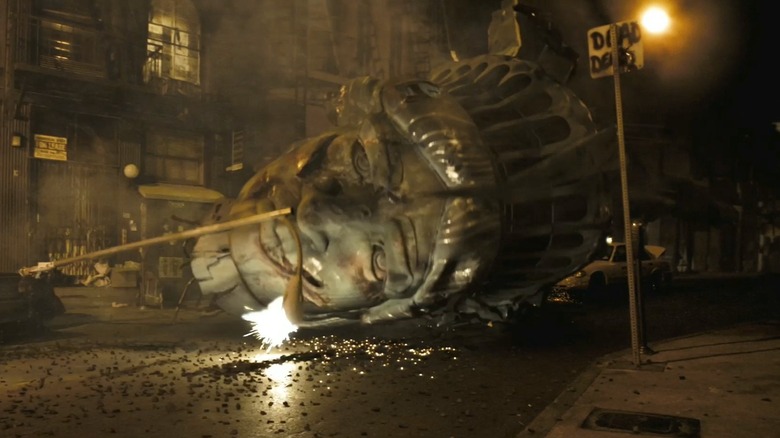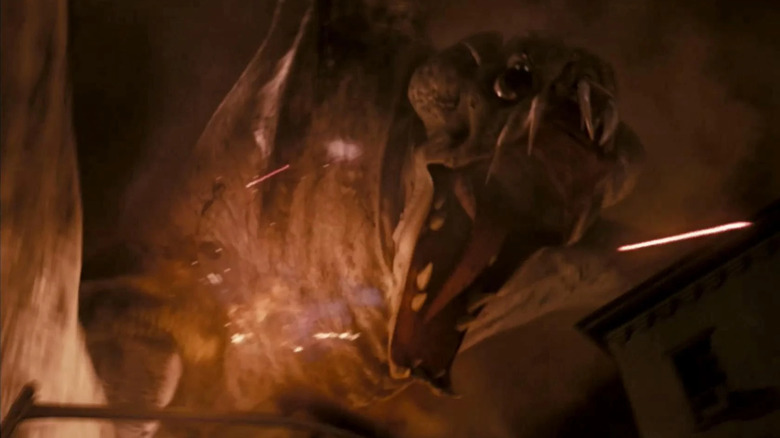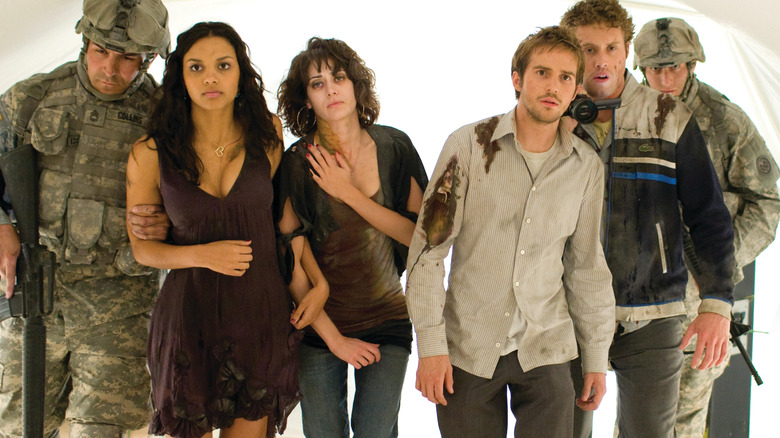
Matt Reeves' 2008 film "Cloverfield" was, prior to its release, shrouded in mystery. Advertising only hinted at some kind of horrendous, monster-based disaster, but was coy as to the exact nature of the threat. All people knew was that the Statue of Liberty was going to suffer some kind of major trauma: its head was ripped off and thrown down a Manhattan street. Those around at the time will likely recall rumors that "Cloverfield" was secretly a Godzilla film, and that the title was only a code word.
The title was, in fact, a meaningless word that had nothing to do with the content of the film itself. It merely happens that executive producer J.J. Abrams worked out of an office on Cloverfield Blvd. in Santa Monica, CA.
"Cloverfield" was also a notable entry in the then-growing trend of found-footage genre movies that peppered the landscape. The handheld aesthetic, and the conceit that one of the characters is filming the action themselves, was called an exhilarating clarion call for a new generation -- the MySpace Generation -- of filmmaking; yes, there was a time when found footage wasn't yet considered tired or contrived.
It was also something not many audiences in 2008 were used to. The quick, shaky cameras were said, especially by those sitting in the front rows of the theater, to give some viewers nausea. The kind of camera movements in "Cloverfield" were likely to give people motion sickness. /Film's own B.J. Colangelo even confessed to this author that she threw up in the theater as a result of the cinematography (provided by Michael Bonvillain).
According to a 2008 report by ABC News, certain AMC Theatres locations had to go so far as to post warnings for the queasiness-prone.
Blair Witch On Crack

According to ABC, "Cloverfield" opened in 278 theaters, employing about 500 screens, and most theaters posted the following warning:
"Due to the filming method used for 'Cloverfield,' guests viewing this film may experience side effects associated with motion sickness, similar to riding a roller coaster."
Anyone who got sick during the film would be issued a refund. One viewer described the film as "Blair Witch on crack," in reference to Eduardo Sánchez's and Daniel Myrick's 1999 found footage film "The Blair Witch Project." Said viewer left after an hour to avoid the extreme vertigo the film gave him. Luckily, the mystery kept the viewer, named Sam Friedman, in his seat, "I stayed for about an hour just to find out what the hell a Cloverfield was."
It seems "The Blair Witch Project" elicited similar reactions from audiences a decade previous. A 1999 report in the Guardian also found that viewers had to frequently leave the theater because of the shaky-cam in order to drink water and regain their bearings. Theaters showing "Blair Witch Project" even implored people to vomit in the provided bathrooms, not in the lobby. Such a posted warning means, quite unfortunately, that some poor theater worker definitely had to mop up someone's sick.
Of course, with both "The Blair Witch Project" and "Cloverfield," the reports of viewers throwing up served less as a warning and more as a means to enhance both films' mythic status. "Blair Witch Project" was so well marketed that some viewers assumed it was an actual documentary and that the actors in the film had indeed died. In 1999, it was briefly the stuff of urban legends.
The Ultimate Gimmick

Meanwhile, the content of "Cloverfield" was so well-guarded that many viewers didn't know it was a monster movie going in (hence the comment above about wanting to find out what a Cloverfield was). The title was mysterious, the plot was not revealed, and many didn't know if there was even a monster or not. Indeed, one might recall some fans whingeing that the film's big reveal was that "it was just a monster." It seems that "Cloverfield" was merely a modern kaiju film. But the mystery left people intrigued. And reports of viewers throwing up only added to the fun. Wanna go see the movie that will make us barf? Bro, I am so there. One can be certain that the studio accepted reports of in-theater sickness as the best possible press.
Barf became the gimmick.
Indeed, other films in the past have been careful to advertise that they were so very extreme that vomiting was all but guaranteed. Michael Armstrong's 1970 horror film "Mark of the Devil" famously distributed vomit bags to ticket buyers, implying that their film was not for the faint of heart ... or stomach. Only two years later, Paul Leder's film "I Dismember Mama" attempted a similar gimmick by handing out "Up-Chuck Cups." Decades later, attendees of Spike & Mike's Sick and Twisted Festival of Animation were given barf bags before watching "classics" like "Sloaches Fun House." As far as cursory research can reveal, there were no reports of people actually throwing up during "Mark of the Devil" of "I Dismember Mama," but this author remembers being extremely grossed out by "Sloaches Fun House."
Of course, none of these films are fun for the people who actually threw up.
Read this next: 20 Movies About Aliens That You Definitely Need To Watch
The post Cloverfield's Shaky Camera Style Resulted in Warnings Posted Outside Movie Theaters appeared first on /Film.
0 Comments